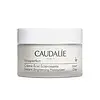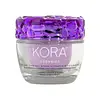What's inside
What's inside
 Key Ingredients
Key Ingredients

 Benefits
Benefits

 Concerns
Concerns

 Ingredients Side-by-side
Ingredients Side-by-side

Water
Skin ConditioningGlycerin
HumectantDicaprylyl Carbonate
EmollientSqualane
EmollientOctyldodecyl Myristate
EmollientC20-22 Alkyl Phosphate
EmulsifyingC20-22 Alcohols
Emulsion StabilisingPaeonia Lactiflora Root Extract
Skin ConditioningPalmitoyl Grapevine Shoot Extract
AntioxidantBisabolol
MaskingCitrus Aurantium Amara Flower Water
MaskingSaccharide Isomerate
HumectantNiacinamide
SmoothingParfum
MaskingCarbomer
Emulsion StabilisingSilica
AbrasiveCI 77891
Cosmetic ColorantEthylhexylglycerin
Skin ConditioningMica
Cosmetic ColorantSodium Hydroxide
BufferingSodium Phytate
Sodium Hyaluronate
HumectantCitric Acid
BufferingTin Oxide
AbrasiveSodium Citrate
BufferingTocopherol
AntioxidantPotassium Sorbate
PreservativeSodium Benzoate
MaskingWater, Glycerin, Dicaprylyl Carbonate, Squalane, Octyldodecyl Myristate, C20-22 Alkyl Phosphate, C20-22 Alcohols, Paeonia Lactiflora Root Extract, Palmitoyl Grapevine Shoot Extract, Bisabolol, Citrus Aurantium Amara Flower Water, Saccharide Isomerate, Niacinamide, Parfum, Carbomer, Silica, CI 77891, Ethylhexylglycerin, Mica, Sodium Hydroxide, Sodium Phytate, Sodium Hyaluronate, Citric Acid, Tin Oxide, Sodium Citrate, Tocopherol, Potassium Sorbate, Sodium Benzoate
Aloe Barbadensis Leaf Juice
Skin ConditioningGlycerin
HumectantCetearyl Alcohol
EmollientCoconut Alkanes
EmollientWater
Skin ConditioningHelianthus Annuus Flower
Skin ConditioningLactobacillus Ferment
Skin ConditioningSorbitan Olivate
EmulsifyingCetearyl Olivate
Butyrospermum Parkii Butter
Skin ConditioningEuterpe Oleracea Fruit Extract
Bakuchiol
AntimicrobialRosa Canina Fruit Oil
EmollientLactobacillus
Skin ConditioningCeramide NP
Skin ConditioningCoco-Caprylate/Caprate
EmollientEragrostis Tef Seed Extract
EmollientSclerotium Gum
Emulsion StabilisingCocos Nucifera Fruit Extract
EmollientPotassium Sorbate
PreservativeMedicago Sativa Extract
TonicEclipta Prostrata Extract
Skin ConditioningCitric Acid
BufferingMelia Azadirachta Leaf Extract
Skin ConditioningPelargonium Graveolens Flower Oil
MaskingSodium Phytate
Citrus Aurantium Amara Flower Oil
MaskingMelia Azadirachta Flower Extract
Skin ConditioningCorallina Officinalis Extract
Skin ConditioningSodium Benzoate
MaskingMorinda Citrifolia Fruit Extract
Skin ConditioningCoccinia Indica Fruit Extract
Skin ConditioningTocopherol
AntioxidantMoringa Oleifera Seed Oil
EmollientSolanum Melongena Fruit Extract
Skin ConditioningAloe Barbadensis Flower Extract
EmollientSimmondsia Chinensis Seed Oil
EmollientCurcuma Longa Root Extract
MaskingOcimum Basilicum Flower/Leaf Extract
TonicOcimum Sanctum Leaf Extract
Skin ConditioningAlcohol
AntimicrobialLinalool
PerfumingCitronellol
PerfumingGeraniol
PerfumingLimonene
PerfumingFarnesol
PerfumingAloe Barbadensis Leaf Juice, Glycerin, Cetearyl Alcohol, Coconut Alkanes, Water, Helianthus Annuus Flower, Lactobacillus Ferment, Sorbitan Olivate, Cetearyl Olivate, Butyrospermum Parkii Butter, Euterpe Oleracea Fruit Extract, Bakuchiol, Rosa Canina Fruit Oil, Lactobacillus, Ceramide NP, Coco-Caprylate/Caprate, Eragrostis Tef Seed Extract, Sclerotium Gum, Cocos Nucifera Fruit Extract, Potassium Sorbate, Medicago Sativa Extract, Eclipta Prostrata Extract, Citric Acid, Melia Azadirachta Leaf Extract, Pelargonium Graveolens Flower Oil, Sodium Phytate, Citrus Aurantium Amara Flower Oil, Melia Azadirachta Flower Extract, Corallina Officinalis Extract, Sodium Benzoate, Morinda Citrifolia Fruit Extract, Coccinia Indica Fruit Extract, Tocopherol, Moringa Oleifera Seed Oil, Solanum Melongena Fruit Extract, Aloe Barbadensis Flower Extract, Simmondsia Chinensis Seed Oil, Curcuma Longa Root Extract, Ocimum Basilicum Flower/Leaf Extract, Ocimum Sanctum Leaf Extract, Alcohol, Linalool, Citronellol, Geraniol, Limonene, Farnesol
 Reviews
Reviews

Ingredients Explained
These ingredients are found in both products.
Ingredients higher up in an ingredient list are typically present in a larger amount.
Citric Acid is an alpha hydroxy acid (AHA) naturally found in citrus fruits like oranges, lemons, and limes.
Like other AHAs, citric acid can exfoliate skin by breaking down the bonds that hold dead skin cells together. This helps reveal smoother and brighter skin underneath.
However, this exfoliating effect only happens at high concentrations (20%) which can be hard to find in cosmetic products.
Due to this, citric acid is usually included in small amounts as a pH adjuster. This helps keep products slightly more acidic and compatible with skin's natural pH.
In skincare formulas, citric acid can:
While it can provide some skin benefits, research shows lactic acid and glycolic acid are generally more effective and less irritating exfoliants.
Most citric acid used in skincare today is made by fermenting sugars (usually from molasses). This synthetic version is identical to the natural citrus form but easier to stabilize and use in formulations.
Read more about some other popular AHA's here:
Learn more about Citric AcidGlycerin is already naturally found in your skin. It helps moisturize and protect your skin.
A study from 2016 found glycerin to be more effective as a humectant than AHAs and hyaluronic acid.
As a humectant, it helps the skin stay hydrated by pulling moisture to your skin. The low molecular weight of glycerin allows it to pull moisture into the deeper layers of your skin.
Hydrated skin improves your skin barrier; Your skin barrier helps protect against irritants and bacteria.
Glycerin has also been found to have antimicrobial and antiviral properties. Due to these properties, glycerin is often used in wound and burn treatments.
In cosmetics, glycerin is usually derived from plants such as soybean or palm. However, it can also be sourced from animals, such as tallow or animal fat.
This ingredient is organic, colorless, odorless, and non-toxic.
Glycerin is the name for this ingredient in American English. British English uses Glycerol/Glycerine.
Learn more about GlycerinPotassium Sorbate is a preservative used to prevent yeast and mold in products. It is commonly found in both cosmetic and food products.
This ingredient comes from potassium salt derived from sorbic acid. Sorbic acid is a natural antibiotic and effective against fungus.
Both potassium sorbate and sorbic acid can be found in baked goods, cheeses, dried meats, dried fruit, ice cream, pickles, wine, yogurt, and more.
You'll often find this ingredient used with other preservatives.
Learn more about Potassium SorbateSodium Benzoate is a preservative. It's used in both cosmetic and food products to inhibit the growth of mold and bacteria. It is typically produced synthetically.
Both the US FDA and EU Health Committee have approved the use of sodium benzoate. In the US, levels of 0.1% (of the total product) are allowed.
Sodium benzoate works as a preservative by inhibiting the growth of bacteria inside of cells. It prevents the cell from fermenting a type of sugar using an enzyme called phosphofructokinase.
It is the salt of benzoic acid. Foods containing sodium benzoate include soda, salad dressings, condiments, fruit juices, wines, and snack foods.
Studies for using ascorbic acid and sodium benzoate in cosmetics are lacking, especially in skincare routines with multiple steps.
We always recommend speaking with a professional, such as a dermatologist, if you have any concerns.
Learn more about Sodium BenzoateSodium Phytate is the synthetic salt form of phytic acid. Phytic acid is an antioxidant and can be found in plant seeds.
Sodium Phytate is a chelating agent. Chelating agents help prevent metals from binding to water. This helps stabilize the ingredients and the product.
Tocopherol (also known as Vitamin E) is a common antioxidant used to help protect the skin from free-radicals and strengthen the skin barrier. It's also fat soluble - this means our skin is great at absorbing it.
Vitamin E also helps keep your natural skin lipids healthy. Your lipid skin barrier naturally consists of lipids, ceramides, and fatty acids. Vitamin E offers extra protection for your skin’s lipid barrier, keeping your skin healthy and nourished.
Another benefit is a bit of UV protection. Vitamin E helps reduce the damage caused by UVB rays. (It should not replace your sunscreen). Combining it with Vitamin C can decrease sunburned cells and hyperpigmentation after UV exposure.
You might have noticed Vitamin E + C often paired together. This is because it is great at stabilizing Vitamin C. Using the two together helps increase the effectiveness of both ingredients.
There are often claims that Vitamin E can reduce/prevent scarring, but these claims haven't been confirmed by scientific research.
Learn more about TocopherolWater. It's the most common cosmetic ingredient of all. You'll usually see it at the top of ingredient lists, meaning that it makes up the largest part of the product.
So why is it so popular? Water most often acts as a solvent - this means that it helps dissolve other ingredients into the formulation.
You'll also recognize water as that liquid we all need to stay alive. If you see this, drink a glass of water. Stay hydrated!
Learn more about Water